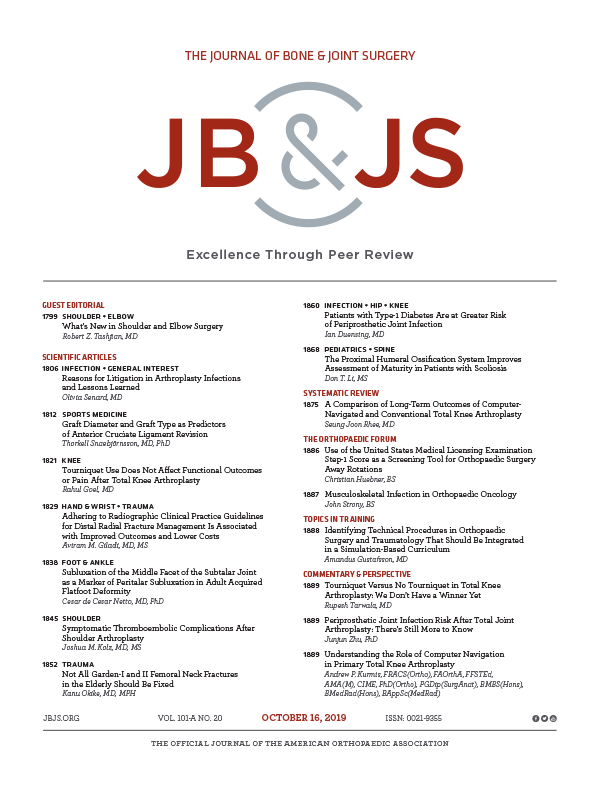
Non-operative treatment of the MCL in combined ACL MCL injuries

Non-operative treatment of the MCL in combined ACL MCL injuries
Range of Motion and Quadriceps Muscle Power After Early Surgical Treatment of Acute Combined Anterior Cruciate and Grade-III Medial Collateral Ligament Injuries. A Prospective Randomized Study
J Bone Joint Surg Am. 2009 Jun;91(6):1305-12.Did you know you're eligible to earn 0.5 CME credits for reading this report? Click Here
Synopsis
47 patients with combined anterior cruciate ligament (ACL) and medial collateral ligament (MCL) injuries were randomized to receive either operative treatment on both ACL and MCL or operative treatment just on ACL. It was observed that the non-operative treatment of the MCL led to a greater range of motion and recovery of quadriceps power generation during early follow-ups.
Was the allocation sequence adequately generated?
Was allocation adequately concealed?
Blinding Treatment Providers: Was knowledge of the allocated interventions adequately prevented?
Blinding Outcome Assessors: Was knowledge of the allocated interventions adequately prevented?
Blinding Patients: Was knowledge of the allocated interventions adequately prevented?
Was loss to follow-up (missing outcome data) infrequent?
Are reports of the study free of suggestion of selective outcome reporting?
Were outcomes objective, patient-important and assessed in a manner to limit bias (ie. duplicate assessors, Independent assessors)?
Was the sample size sufficiently large to assure a balance of prognosis and sufficiently large number of outcome events?
Was investigator expertise/experience with both treatment and control techniques likely the same (ie.were criteria for surgeon participation/expertise provided)?
Yes = 1
Uncertain = 0.5
Not Relevant = 0
No = 0
The Reporting Criteria Assessment evaluates the transparency with which authors report the methodological and trial characteristics of the trial within the publication. The assessment is divided into five categories which are presented below.
3/4
Randomization
3/4
Outcome Measurements
2/4
Inclusion / Exclusion
4/4
Therapy Description
4/4
Statistics
Detsky AS, Naylor CD, O'Rourke K, McGeer AJ, L'Abbé KA. J Clin Epidemiol. 1992;45:255-65
The Fragility Index is a tool that aids in the interpretation of significant findings, providing a measure of strength for a result. The Fragility Index represents the number of consecutive events that need to be added to a dichotomous outcome to make the finding no longer significant. A small number represents a weaker finding and a large number represents a stronger finding.
Why was this study needed now?
Isolated MCL injuries are commonly treated with non-operative care. However, there is no consensus for the standard of care in patients who have injured both ACL and MCL ligaments in the same knee. Surgical repair of both ligaments, while providing knee stability, has recently found to be associated with decreased post-operative range of motion and quadriceps muscle power. This trial examined differences in range of motion and quadriceps power between operative and non-operative treatment of the MCL in combined ACL and MCL injuries.
What was the principal research question?
In patients with combined ACL and MCL injuries (tears), does non-operative treatment of the MCL provide better postoperative range of motion, without sacrificing stability when compared to operative repair?
What were the important findings?
- Flexion deficit was greater in the MCLS group (both ACL and MCL repair) at all follow-up time points, but was only significant at 6 weeks (100 vs 112 degrees; p=0.009), 12 weeks (119 vs 128 degrees; p=0.043), and 32 weeks (130 vs 136 degrees; p=0.011)
- At 1 and 2 year follow-up, knee flexion was similar between the two groups (MCLS =132 and MCLNO= 134 degrees; MCLS=134 and MCLNO=137 degrees)
- At 1 year, quadriceps muscle power was 30.7% in the MCLS group and 20.5% in the MCLNO group (p=0.015). At 104 weeks, this difference was no longer significant, but favoured the MCLNO group (14.4% vs 9.7%; p=0.2)
- 96% (45/47) patients exhibited normal flexion, according to the International Knee Documentation Committee criteria
What should I remember most?
Results from this study favoured the non-operative treatment for the MCL in patients with combined ACL and MCL injuries. At one year, quadriceps muscle power was greater in the non-operative group. However, at two years, muscle power, and ROM were equal in both groups.
How will this affect the care of my patients?
This study indicates that non-operative treatment of the MCL in combined ACL and MCL injuries provides improved quadriceps muscle power recovery and ROM when examined during short term follow-up, with no differences apparent at long term follow-up.
Learn about our AI Driven
High Impact Search Feature
Our AI driven High Impact metric calculates the impact an article will have by considering both the publishing journal and the content of the article itself. Built using the latest advances in natural language processing, OE High Impact predicts an article’s future number of citations better than impact factor alone.
Continue



 LOGIN
LOGIN

Join the Conversation
Please Login or Join to leave comments.